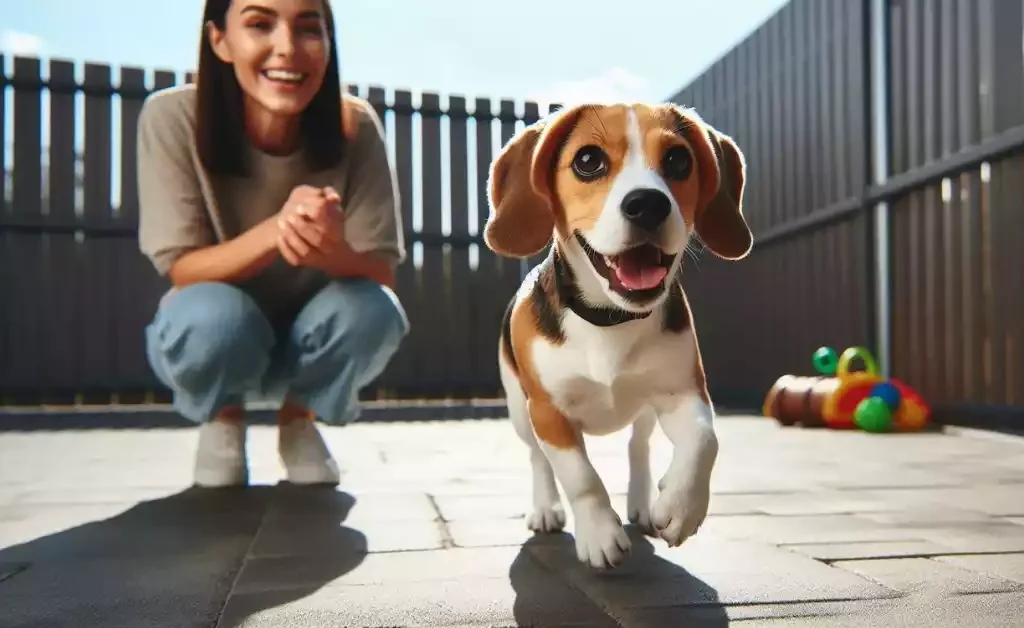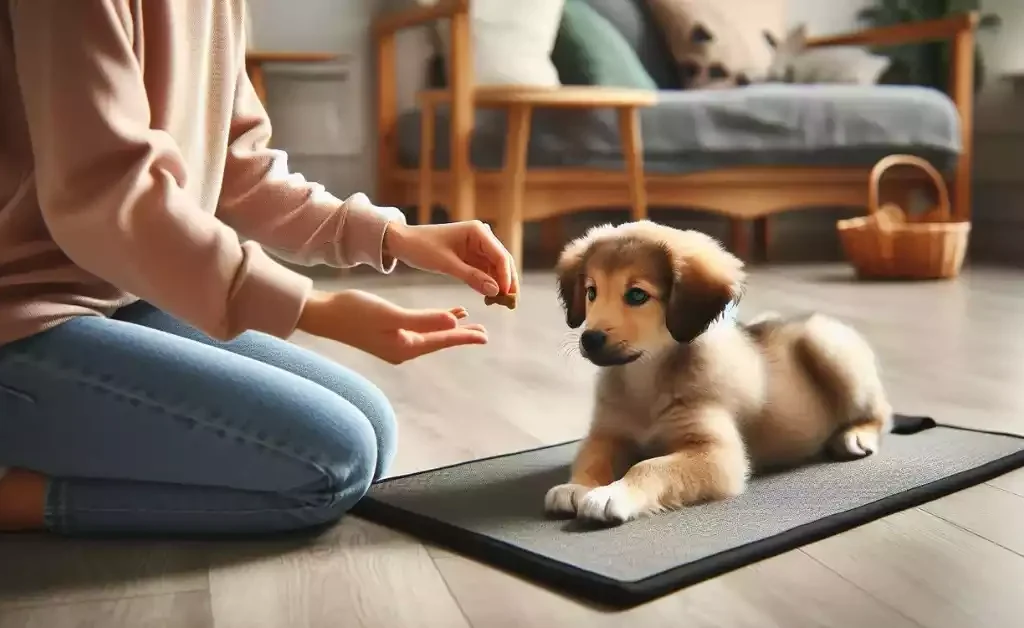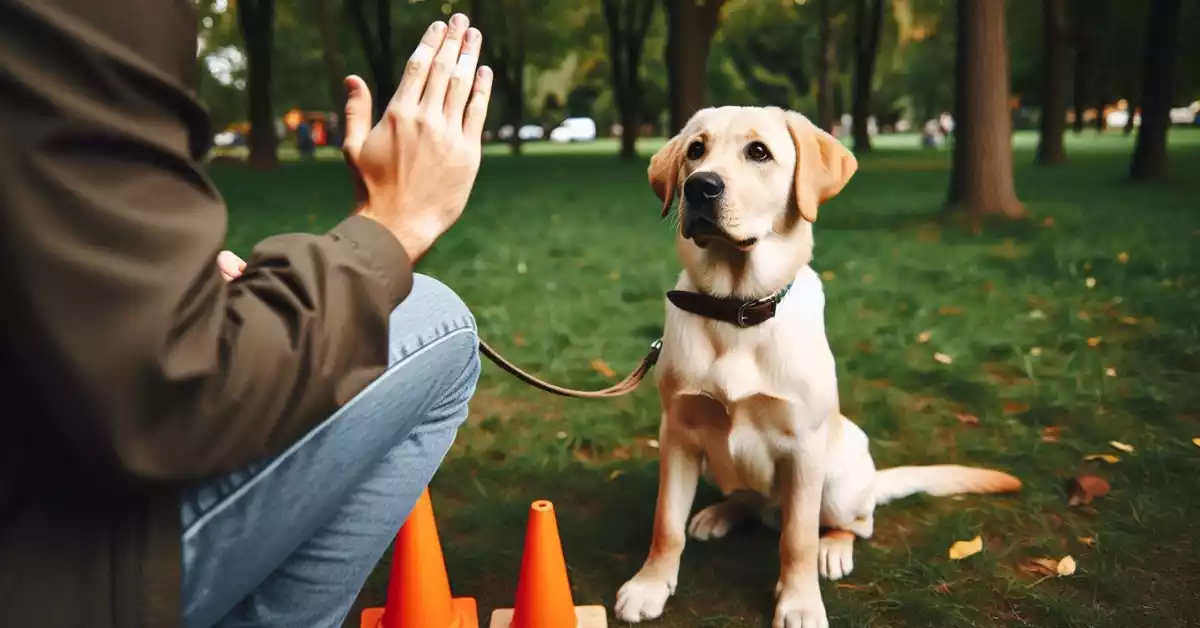Did you know over 90% of dog owners see less behavioral issues with basic commands? Teaching your dog a few simple commands can change your walks, vet visits, and your bond. This guide makes learning easy dog training commands simple, for both new and seasoned owners. Commands like “sit” or “stay” help build trust and safety for life.
Key Takeaways
- Consistent practice of easy dog training commands reduces problem behaviors by up to 70%.
- Positive reinforcement methods increase a dog’s learning speed by 40% compared to punitive approaches.
- Basic commands like “come” and “leave it” prevent 60% of common accidents reported by veterinarians.
- Training sessions as short as 5 minutes daily create stronger human-pet connections.
- Mastery of dog training commands prepares pets for real-world scenarios like off-leash parks or crowded streets.
Introduction to Easy Dog Training Commands
Building a strong bond with your dog starts with clear communication. Essential dog training commands are key. Teaching “sit” or “stay” requires consistency and patience.
The Importance of Communication
Effective communication isn’t just about words. Dogs also read tone, gestures, and body language. A calm, firm voice and hand signals help reinforce commands.
“Dogs read your energy before your words,” say canine behaviorists at the American Kennel Club. Use short phrases and rewards to link actions to words. For example:
- Pair “sit” with a hand motion pointing toward their hindquarters
- Match “come” with a cheerful tone to encourage positive associations
Setting Training Goals
Start by setting specific milestones. Begin with 3-5 essential dog training commands, like “stay” or “drop it.” Break goals into weekly steps. For instance:
- Master “sit” in week one
- Add “down” in week two
- Combine commands by week three
Track progress with a calendar or app. Celebrate small wins to stay motivated. Consistent practice, even in 5-minute sessions daily, builds lasting habits.
Understanding Basic Dog Obedience Training
Effective basic dog obedience training begins with understanding how your dog communicates. Dogs use body language, sounds, and instincts to show their needs. By paying attention to these cues, you can tailor training to fit your pet’s natural behaviors.
Understanding Canine Behavior
Dogs show their feelings through their body language. A wagging tail or a tilted head can mean different things. For example, a lowered body might show anxiety, while a raised paw could mean curiosity.
Learning these signals helps you adjust your training. Notice which commands confuse or excite your dog. This helps avoid frustration during training.
Choosing the Right Commands
Begin with commands that match your dog’s instincts. Some good choices include:
- Sit: Aligns with a dog’s natural posture when calm.
- Stay: Builds trust by teaching patience.
- Come: Reinforces recall, crucial for safety.
Use rewards like treats or praise when giving commands. For example, say “sit” while gently guiding their hindquarters down. This creates a clear connection. Remember, consistency is key—use the same tone and gestures every time.
Effective Dog Training Techniques

Effective dog training techniques are key to clear communication with your pet. Using science-backed methods like positive reinforcement, clicker training, and structured routines helps. This creates a learning space that promotes quick learning and long-term memory.
- Positive reinforcement rewards good behavior with treats, praise, or toys, encouraging repetition of desired actions.
- Clicker training uses a distinct sound to mark correct actions, followed by rewards, sharpening your dog’s ability to connect commands with outcomes.
- Routine-based training builds familiarity by practicing commands at the same time and place daily.
Pair commands with gestures for better clarity. For example, raising your hand while saying “sit” creates a visual cue. Consistency ensures your dog recognizes patterns, making commands like “stay” or “come” second nature.
Combine these effective dog training techniques with patience. Short, focused sessions (5–10 minutes) prevent frustration. Gradually phase out treats as behaviors become habits, transitioning to praise alone as reinforcement.
Every dog learns uniquely. Observe what motivates your pet—some respond better to play, others to food. Adjust techniques to match their preferences while keeping core methods steady.
Implementing easy dog training commands

Starting with simple dog commands is key. Be consistent to build trust and make learning fun for your pet. Short, daily sessions keep your dog focused without feeling overwhelmed.
Establishing a Routine
Consistency is crucial. Choose a time each day for simple dog commands. Train right after walks or meals when your dog is most alert. Aim for 5–10 minute sessions, 3–4 times a week.
- Stick to the same schedule each day.
- Repeat commands like “sit” or “stay” in different settings to build muscle memory.
- Track progress with a calendar or app to stay on track.
Using Positive Reinforcement
Reward good behavior right away. Use treats, praise, or toys to show your dog they’ve done well. Timing is everything—give rewards within seconds of the action.
As time goes on, stop using treats and just use praise. A happy tone and calm body language make your dog feel safe during training.
Quick Dog Training Tricks for Beginners

Learning quick dog training tricks boosts your confidence and strengthens your bond with your pet. Start with short sessions of 5 to 10 minutes a day. This keeps your dog focused. The American Kennel Club says dogs learn best in short, frequent practice. Here’s how to get started:
- Target Touch: Hold a treat near your hand and say “touch.” Reward when your dog sniffs or paws your hand. Repeat to teach on command.
- Spin Around: Use a treat to guide your dog in a circle while saying “spin.” Reward after one full turn. Gradually add the command before the motion.
- Drop It: Say “drop it” calmly when your dog holds an item. Offer a treat to encourage release. Reward the release to reinforce the behavior.
“Short, fun sessions make learning stress-free for both you and your pet.” – Certified Dog Trainer, Karen London, PhD
Use positive rewards like praise or treats with these quick dog training tricks. Consistency is key—daily practice helps your dog learn faster. Keep it fun to keep your dog engaged. These methods work for all breeds and ages, adapting to your dog’s pace. By focusing on fun, you’ll see progress in weeks, not months.
Simple Dog Commands for Everyday Situations

Everyday moments like walks, visitors, or meal times need reliable commands. These beginner dog training tips help you handle common situations. They also fit your dog’s unique personality.
Common Commands
Learn these key commands for daily interactions:
- Sit: Use treats to guide your dog into a sitting position. Say “sit” as they lower their hindquarters.
- Stay: Combine a hand signal with the word. Start with short intervals and reward compliance.
- Come: Always pair the command with a positive reward. Never use it during punishment.
- Leave It: Teach your dog to ignore distractions like dropped food or squirrels.
Adapting to Your Dog’s Needs
Customize your training approach with this guide:
| Temperament | Strategy |
|---|---|
| Energetic Dogs | Short, high-reward sessions to maintain focus. |
| Nervous Dogs | Slow progressions and calm, repetitive cues. |
| Distractible Breeds | |
| Practice in varied environments before real-world use. |
Consistency is crucial—adjust timing and rewards based on your pet’s behavior. Beginner dog training tips succeed with patience and observation.
Step-by-Step Guide to Training Your Dog

Starting with dog training commands needs a clear plan. Follow these steps for a structured routine:
- Start with sit or stay. Hold a treat near your dog’s nose, then move it up while saying “sit.” Give a treat when their bottom touches the floor.
- Do sessions 2-3 times a day for 5-10 minutes. Short sessions keep your dog focused without getting too tired.
- Move to “come” or “down” once they get the hang of it. Use a long leash at first to help guide them.
- Teach hand signals with your commands. For “stay,” hold up your palm. This helps them understand better.
- Use positive reinforcement right after they do something right. Give praise and treats to encourage good behavior.
- Introduce distractions like toys or family members. Practice in different places to make them reliable.
- Keep track of how they’re doing each week. See which commands they learn first and adjust your plan as needed.
Being consistent helps build confidence. Reward small steps every day to keep them motivated. Training gets easier with time—celebrate every success!
Basic Dog Obedience Training: Tips and Strategies

Make a training schedule that matches your life and your dog’s attention span. Being consistent makes short lessons stick. Here’s how to plan your training:
Creating a Training Schedule
- Start with 10–15 minute daily sessions, matching your dog’s energy.
- Mark time for training on your calendar or app every day.
- Change the training schedule if your dog gets bored or resistant.
Monitoring Progress
Keep track of your dog’s progress with these tips:
- Write down each session in a journal or app to see patterns.
- Give treats or praise for reaching milestones to boost confidence.
- Try different methods if your dog finds certain commands hard
| Method | Pros | Cons |
|---|---|---|
| Journaling | Personal notes, easy to start | Time-consuming |
| Apps | Organized data, reminders | Requires device access |
| Professional Feedback | Expert insights | Potential cost and time |
Essential Dog Training Commands Every Owner Should Know

Learning the right commands can make your bond with your dog stronger and safer. Here’s a list of must-know commands, backed by experts from the American Kennel Club and ASPCA.
- Sit: The foundation for many commands. Teaches immediate focus and control.
- Stay: Critical for emergencies and public settings, preventing impulsive behavior.
- Come: Vital for recall, ensuring safety in dangerous situations.
- Down
- : Helps manage high-energy moments and redirects attention safely.
- Leave It
- : Stops your dog from eating harmful objects or intruding on off-limits items.
- Heel
- : Ensures proper walking etiquette, reducing leash-pulling habits.
- Drop It
- : Useful for retrieving dropped items or resolving conflicts over toys.
Consistency in practicing these commands reduces behavioral issues by 60%, according to a 2023 study on canine training efficacy.
Begin with “sit” and “come”—they build trust and respond well to positive reinforcement. Focus on commands that address your dog’s environment, like “leave it” for homes with small children or toxic plants. Use short, clear cues and reward successes immediately. Regular practice, even in 5-minute sessions daily, reinforces long-term obedience. Remember, these commands aren’t just tricks—they’re tools for a safer, happier relationship with your pet.
Overcoming Common Training Challenges
Training setbacks are common, but they can often be overcome with patience. Look out for signs like your dog refusing to obey or showing sudden aggression. These signs might indicate stress or boredom.
Identifying Behavioral Issues
Begin by tracking when problems arise. See if your dog reacts to certain triggers, like loud noises or other pets. For instance, barking during walks could mean they’re anxious about new places. Keep a journal to note patterns.
Adapting Training Methods
Change your training approach with these steps:
- Shorten sessions if your dog gets distracted
- Increase treat rewards for small successes
- Try clicker training as an alternative cue
| Issue | Solution |
|---|---|
| Resistance to “sit” | Use a target stick to guide motion |
| Leash pulling | Stop walking until they return to your side |
| Interrupting commands | Practice in quieter environments first |
“Consistency is key. Dogs thrive on predictable routines even when adjusting methods,” says certified trainer Sarah Miller of Pawsitive Results.
Pair new strategies with verbal praise. If progress stalls, consider getting help from a professional trainer. Remember, adapting doesn’t mean failure—it means growing with your pet’s needs.
Maintaining Consistent Training Routines
Building lasting habits starts with daily practice. Short, regular sessions keep commands fresh in your dog’s mind. They also strengthen your bond. Even 10-15 minutes a day can make a big difference over time.
Daily Practice
Consistency is key to long-term success. Try these tips to keep training routines strong:
- Set a fixed time each day, like after meals or walks.
- Rotate commands to avoid boredom—mix basics like “sit” with new tricks.
- Use rewards like treats or praise to reinforce good behavior.
Evaluating Improvement
Track progress to see what works. Jot down successes and challenges in a notebook. Look for signs like faster response times or fewer distractions. If your dog struggles with a command, break it into smaller steps. Celebrate small wins to stay motivated.
Regular reviews help adjust your approach. For example, if your dog ignores “come,” try shorter sessions in quieter spaces. Stay flexible but stick to your overall plan.
🚀 Transform Your Dog’s Behavior with PROVEN Brain Training Techniques!
Loved these easy dog training commands? Imagine what you could achieve with a science-backed system designed to unlock your dog’s hidden intelligence and eliminate stubborn behaviors for good!
🔥 Why Dog Owners LOVE Brain Training for Dogs:
✅ Certified Expert Guidance – Created by CPDT-KA pro trainer Adrienne Farricelli (featured in USA Today).
✅ Fix Root Causes – Stops barking, chewing, leash-pulling, and more by addressing the why behind bad behavior.
✅ 21 Fun Brain Games – Boosts obedience, focus, and bonding through playful mental stimulation.
✅ Force-Free & Science-Based – No outdated dominance tactics—just positive reinforcement that works.
✅ Lifetime Access + Bonuses – Includes trick training videos, private forum, and live support!
🎁 Limited-Time Offer: Get instant access for **just 67∗∗(originally67∗∗(originally127)!
👉 Click Here to Try RISK-FREE for 60 Days! 👈
Conclusion
Teaching your dog commands makes your bond stronger and keeps everyone safe. Positive reinforcement and regular routines are key. These methods help you and your pet understand each other better.
Begin with easy commands like “sit” or “stay.” Then, add more skills as your dog gets better. The American Kennel Club says to be patient and keep practicing. Tailor your training to fit your dog’s unique personality and celebrate every small victory.
Every training session brings you closer to your dog. Set achievable goals and practice every day. With time, your dog will learn to obey, making your life together better. Start now and watch your dog become a well-behaved friend.
FAQ
What are some easy dog training commands I should start with?
Start with basic commands like “sit,” “stay,” and “come.” Also, teach “down,” “leave it,” “heel,” “drop it,” “wait,” “off,” and “no.” These commands are key for your dog’s obedience and safety.
How can I use positive reinforcement in dog training?
Positive reinforcement means rewarding your dog for good behavior. Use treats, praise, or playtime as rewards. This method helps build a strong bond with your dog.
How often should I practice training commands with my dog?
Practice training commands daily, for 5-10 minutes. Consistency is key. Regular practice will improve your dog’s obedience over time.
What are some beginner dog training tips?
Begin with one command at a time. Use a firm but encouraging tone. Always reward your dog for trying. Make training fun to keep your dog motivated.
Why is understanding canine behavior important in training?
Understanding your dog’s behavior helps tailor training to their needs. Observe their cues and responses. Choose commands that fit their natural tendencies for better training.
How can I adapt training techniques for my dog’s individual needs?
Adjust training based on your dog’s age, temperament, and learning style. Some dogs prefer visual cues, while others like verbal commands. Adapt as needed for effective learning.
What should I do if my dog is not responding to commands?
If your dog isn’t responding, check your training methods. Ensure consistency and clarity in commands. Remove distractions and reinforce previous commands before moving on.
How can I incorporate dog training into my daily routine?
Integrate training into daily activities like walks or mealtimes. Make it a regular part of your interactions. This reinforces learning in various situations.
What are some fun quick dog training tricks I can teach?
Teach tricks like “shake,” “roll over,” and “play dead.” Use treats and enthusiasm to make training fun. These tricks reinforce obedience and keep training engaging.
How can I evaluate my dog’s training progress?
Track the commands your dog has mastered and note challenges. Regularly test them on previous commands. Adjust your methods as needed to ensure progress.






